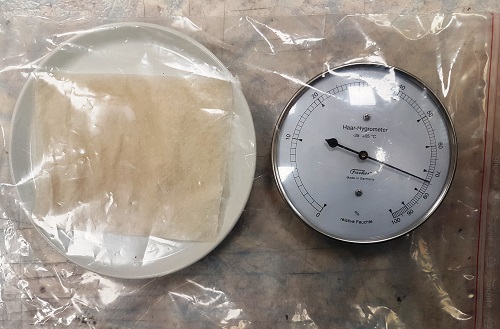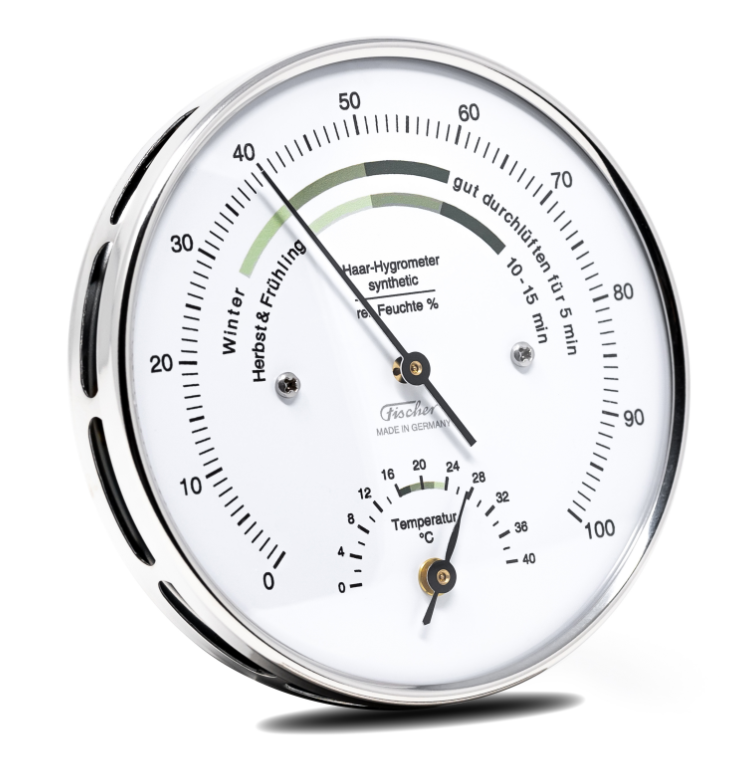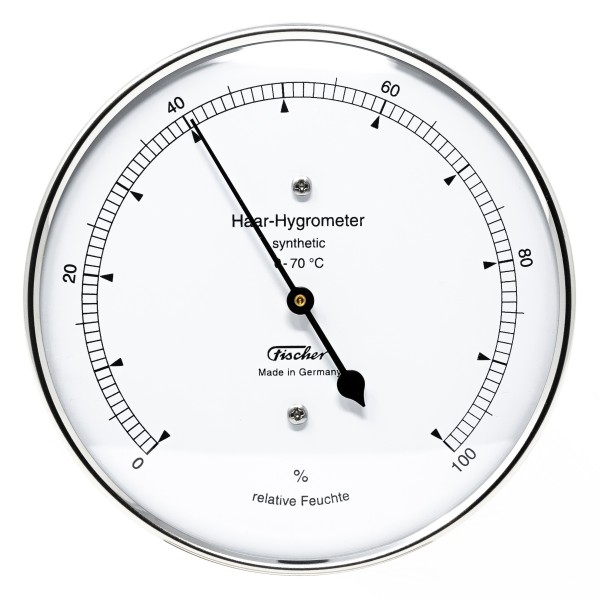The right temperature and optimum humidity ensure healthy living & working. However, creating a healthy indoor climate requires permanent monitoring of the room humidity. Therefore, the use of a hygrometer or a climate meter (combination of thermometer and hygrometer) is essential to maintain a good indoor climate. To be able to reliably monitor your indoor climate, you should regularly calibrate your measuring device.
Content overview
- What is calibration?
- When should a calibration be carried out?
- How is a hygrometer calibrated?
- How is the hygrometer corrected?
- High-quality hygrometers from FISCHER
What is calibration?
A calibration is initially only a comparative measurement: The display value of a measuring device to be tested is compared with the display value of a reference measuring device. Calibration itself does not involve any intervention in the measuring instrument.
However, the comparison measurement can show that the display of the measuring instrument deviates from the reference measurement to such an extent that an adjustment is necessary. It is essential to note that every measurement is subject to a measurement uncertainty (tolerance). This applies to the measuring device itself, but also to the reference measuring device. As long as the deviation of the two display values is within this tolerance, no adjustment of the measuring device is necessary.
If the hygrometer to be calibrated as well as the reference hygrometer have a measuring accuracy of (for example) ± 3 % relative humidity, deviations of the readings of up to 6 % relative humidity are still within the permissible tolerance range.
The differences at different measuring points can also be different. For example, the difference could be 2 % at 30 % relative humidity, but 4 % or 5 % at 75 % relative humidity. A constant difference is possible, but not probable.
When should a calibration be carried out?
Measurement deviations outside the permissible tolerance range can have various causes. Storing the hygrometer for a longer period of time in quite low humidity will cause the display to shift. This is especially true for human hair hygrometers. But also strong vibrations during transport can change the factory adjustment of the hygrometer to such an extent that the displayed measured value is outside the tolerance range. Furthermore, the measuring element of a hygrometer is subject to natural ageing processes that can lead to a shift in the display over time.
We therefore recommend calibrating hygrometers once or twice a year. If the hygrometer is used in a room climate, it makes sense to do this at the end of the heating period, as the hygrometer was exposed to quite low humidity during this time. However, calibration also makes sense if the measuring device has been transported and the displayed value does not seem plausible.
How is a hygrometer calibrated?
Before calibration, the hygrometer should be regenerated in high humidity to reset any display shift that may be present. To do this, expose the hygrometer to changing humidity several times (alternating between saturation humidity and room humidity) and/or place it in a humidity pack overnight (see below).

Comparative measurement with a reference hygrometer
Relative humidity is a temperature-dependent variable. Therefore, it is important that both hygrometers have the same temperature. The best way to achieve this is with a steady flow of air (forced ventilation) by means of a fan (30 to 60 minutes) at constant room temperature. Proximity to heating sources should be avoided, as should other sources of radiation such as direct sunlight. Also make sure that both hygrometers are in the operating position, i.e. positioned upright. Lying on the back of the housing usually leads to a slight change in the pointer position.
After the hygrometers have been adjusted to the existing temperature for a sufficient time (about one hour), you can carry out the comparison measurement. Even during calibration, the temperature should be kept as constant as possible (temperature change <1 °C per hour). Please bear in mind that a temperature difference of only 1 °C at room temperature (depending on humidity) creates an actual existing difference of 2-7 % relative humidity.
In the private sector, one often does not have a reference measuring device that can be used for the comparative measurement. However, there are several pragmatic methods that can be used to create a reference measurement value even in the home. Below you will find the procedures we recommend:
Damp pack
Place your hygrometer in a damp cloth for at least 30 minutes. Also suitable is a tightly closing, transparent plastic bag in which the hygrometer is placed together with a damp cloth. This has the advantage that the reading can be observed at any time. After a dwell time of at least 30 minutes, the hygrometer reading should be in the range of 95-98 % relative humidity. For the reading, the cloth must only be opened, because the hygrometer pointer will abruptly run to a lower value as soon as the hygrometer is taken out of the damp cloth. Furthermore, it must be remembered that the damp pack does not generate a defined humidity value, so the range of 95-98 % is only a guide value. A reading in the range of 92-100 % is still within the tolerance range.
 A value of over 100 % relative humidity (supersaturation) is physically not a stable condition and therefore possible at best for a short time. Nevertheless, the hygrometer display can also be just above 100 %, because the tolerance naturally also applies to the higher value: if the relative humidity is 99 % and the measurement uncertainty is ± 3 % relative humidity, a display value of 102 % relative humidity is still within the tolerance range. A correction of the hygrometer is possible and certainly useful, but not mandatory.
A value of over 100 % relative humidity (supersaturation) is physically not a stable condition and therefore possible at best for a short time. Nevertheless, the hygrometer display can also be just above 100 %, because the tolerance naturally also applies to the higher value: if the relative humidity is 99 % and the measurement uncertainty is ± 3 % relative humidity, a display value of 102 % relative humidity is still within the tolerance range. A correction of the hygrometer is possible and certainly useful, but not mandatory.
Salt solution
Every salt is more or less hygroscopic. This means that it attracts water. If salt is present in a saturated solution, a very constant "equilibrium humidity" is established above this salt solution. At a humidity above the equilibrium humidity, water is absorbed, at a humidity below it, water evaporates. Therefore, in a closed, temperature-constant room, the equilibrium humidity will be established, which can be used for comparison purposes. To produce such a "normal climate", you need pure salt, distilled water and a closed, temperature-constant vessel.
A readily available and harmless salt is sodium chloride. It is available in high purity as regeneration salt for dishwashers or as table salt. It is important to ensure that it contains as few additives as possible (iodine, fluoride, anti-caking agents, etc.). Highly pure (>99.9 %) but also quite expensive, sodium chloride is available in pharmacies.
A saturated solution is prepared from this salt with water (preferably distilled). This requires about 40-50 g of salt for 100 ml of water. Too much salt does no harm as long as all the salt crystals are well wet. The achievable accuracy depends on the purity of the substances used and the constancy of the temperature and can be assumed to be approximately as follows:
Table salt without additives in tap water about 75 % relative humidity ±5 % rel. humidity
Regenerated salt in distilled water about 75 % relative humidity ±2 % rel. humidity
Sodium chloride >99.9 % in distilled water
(at temperature constancy <0.1K/h@25°C) 75.3 % relative humidity <±0.5 % rel. humidity
 Magnesium chloride is also a salt that is well suited for comparative measurements and is harmless. It is commercially available as a food supplement E511, as a component in road salt or as an additive for marine aquariums. However, it is only available in the required purity >99 % in pharmacies. The saturated solution requires about 60-70 g per 100 ml of water.
Magnesium chloride is also a salt that is well suited for comparative measurements and is harmless. It is commercially available as a food supplement E511, as a component in road salt or as an additive for marine aquariums. However, it is only available in the required purity >99 % in pharmacies. The saturated solution requires about 60-70 g per 100 ml of water.
Magnesium chloride hexahydrate p.A.
in distilled water <0.1K/h@25°C) 32.8 % relative humidity ±0.5 % relative humidity
For the comparison measurement, the hygrometer and the saturated solution must be in the same vessel and adjusted at constant temperature for at least 1-2 hours. The vessel should be kept as small as possible, but also allow a view of the hygrometer display. Salt solution and hygrometer must never touch each other, otherwise the hygrometer may be damaged. If both "normal climates" (sodium chloride 75.3 % relative humidity, magnesium chloride 32.8 % relative humidity) are used in succession, the linearity of the hygrometer can be checked (calibration at two different measuring points). For the calibration of a hygrometer, "Humidity Packs" from BOVEDA (or comparable) are also quite practical, which also produce a compensating humidity by means of a saturated salt-water solution. These packs are available for different relative humidities and are placed together with the hygrometer in a tightly closing, transparent plastic bag. However, a tolerance of ±5 % relative humidity must also be taken into account with these "Humidity Packs".
With the methods described, you can determine whether the display of your hygrometer is within the permissible tolerance range. If this is not the case, it is necessary to adjust the display. You should proceed as follows:
How is the hygrometer corrected?
The display is corrected by simply adjusting the pointer position (zero adjustment). The adjustment screw is usually located in one of the openings on the side of the housing. These hygrometers can be easily recognised by the two screws on the dial. Sometimes, however, the adjustment is also made through an opening on the back of the case. If the operating instructions supplied do not give you any clarification, please contact our customer service.
Damp pack
It is very important that the hygrometer is left in the damp cloth. This should only be opened enough to allow access to the adjustment screw. Correct the display of the hygrometer to 98 % relative humidity.
After correcting the display, close the cloth again and wait a few more minutes. Then you can check whether the display actually settles at 98 % relative humidity. A second minor correction may be necessary. In this case, proceed again as described. If you use the plastic bag mentioned above, you can also pierce through the foil with the screwdriver and calmly set the required value. By tapping lightly, the slight friction in the measuring mechanism is released after the adjustment and a more precise setting is possible.
Salt solution
First note the difference in the readings. If, for example, the equilibrium humidity in the vessel was 75 % relative humidity and the hygrometer display 81 % relative humidity, there is a deviation of +6 %. Take the hygrometer out of the vessel and let it adjust to the room climate for at least one hour. Then make the correction in the opposite direction. In the above example, an adjustment of -6 % relative humidity is made. Then repeat the calibration described above. In this way, you can check whether the hygrometer display settles to the value above the salt solution. If necessary, a subsequent correction must be made. To do this, proceed again in the manner described here.
High-quality hygrometers from FISCHER
Humidity plays a major role in our health and well-being. Therefore, the use of a hygrometer or climate meter is essential to maintain a good indoor climate. To obtain accurate readings, these measuring instruments should be calibrated regularly. For this purpose, you can choose from the methods described above.
In our online shop you will find high-quality hygrometers with real or synthetic hair, which are handcrafted for you in our manufactory. Trust in our more than 70 years of experience in the field of hygrometry and convince yourself now! If you have any questions or suggestions, please do not hesitate to contact us by phone at +49 (0) 37341 - 487 0 weekdays from 7:00-15:00 or via our contact form.






